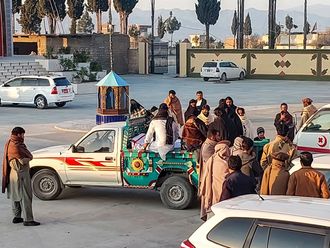
Islamabad: An Asian Leopard Preservation Zone, the first and a unique biodiversity spot nestled in Islamabad’s scenic Margalla Hills National Park (MHNP) is inaugurated to protect and preserve a number of Asian leopards recently spotted along the Trail-6 of the Margalla Hills.
The inauguration of the leopard preservation zone is in line with Prime Minister Imran Khan’s directions last year in October when he while chairing a meeting of the Ministry of Climate Change had directed setting up of a leopard preservation zone in the Margalla Hills to ensure the natural habitat for the endangered species.
The inaugural ceremony was followed by a guided walk inside the zone.
Special Assistant to Prime Minister (SAPM) on Climate Change Malik Amin Aslam inaugurated the zone.
Chairperson of the Islamabad Wildlife Management Board (IWMB) Rina Saeed Khan and mem-bers of the board were also present.
Amin Aslam said the conservation site would help protect critically endangered wildcat and promote wildlife tourism in one of the unique ecosystems close to a human settlement.
“MHNP boasts of variety of plants, birds and animals species”
The special leopard zone will provide healthy eco-system to the predators, permanently inhabiting the hills, she said adding some 300 birds, 350 plant and 20 snakes species can be found in the MHNP that make it a biodiversity rich ecosystem.
“We did not create it … rather nature helped it due to the protection efforts and favourable environmental conditions,” SAPM said while briefing the media persons about the reserve.
“It’s a reaction to the human being’s conflict with nature that transferred Zoonotic diseases to mankind,” he maintained.
'A critically endangered wildlife species'
Speaking on the occasion, Rina Saeed said the leopards remained critically endangered according to the listing of wildlife species of the International Union for Conservation of Nature (IUCN).
They have become permanent residents of Margalla Hills National Park. The animal earlier used it to descend from the upper peaks in winter.
We did a proper scientific camera trap study and placed 20 such traps in the entire 17,000 hec-tares of the national park, she said adding so far, a minimum of seven leopards had been captured by the camera, and there were probably more of them there. “Two males and a female are cur-rently living in the Kalinjar area of Trail-6,” she said.
She said by mid-January, the Trail-6 would be made open for public, students and tourists.
There would be guided tours on the Trail-6 as it would no more be an open trail due to the pres-ence of leopards.
“Though leopard is a nocturnal animal and will not be visible during day times yet through this wildlife tourism initiative, youth and children would learn more about its movement and habitat, she said.
The board would launch a tour once a day with 25-people batch so as to keep the leopards undis-turbed.
For tourists a fee would be charged and the IWMB is working on it, she said.
The Trail-6 was shut for public after the spotting of the first leopard and during the COVID-19 lockdown, its biodiversity thrived which increased the animal’s population.
The news of setting up a leopard preservation zone has become a talk of the town and netizens are terming it yet another climate-friendly step of Prime Minister Imran Khan’s government.












